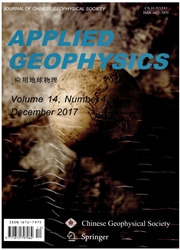

 中文摘要:
中文摘要:
数值求解波动方程是大尺度正演波场模拟、基于波动方程的地震偏移和反演成像的关键.本文针对求解二维声波方程的Runge-Kutta 间断有限元(RKDG)方法的数值频散问题,从理论推导和数值分析的角度进行了深入研究,并将其与近似解析离散化方法(Optimal Nearly Analytic Discrete Method,简称ONAD 方法)、Lax-Wendroff 修正方法、交错网格(Staggered-Grid,简称SG)方法的数值频散进行了比较研究.结果表明:RKDG方法以及近似解析离散化方法在压制数值频散方面要好于上述其他方法,特别是空间精度为3阶的RKDG方法,即使当空间步长取波长的一半,即一个波长内取2个网格点时,最大的频散误差也不超过1.67%.同时,我们也通过波场模拟对比研究了不同数值方法的数值频散问题,进一步直观地验证了数值频散的理论分析结果.
 英文摘要:
英文摘要:
Numerical solving of wave equations is the key point of the forward wave field simulation, seismic migration and the inversion imaging. In this paper, we study the numerical dispersion of the Runge-Kutta discontinuous Galerkin (RKDG) method for solving 2-D acoustic equations, and compare it with the ONAD method, Lax-Wendroff method and the Staggered-Grid method. Our theoretical analysis and numerical tests show that the RKDG method and the ONAD method can suppress the numerical dispersion more effectively. Especially for the three-order RKDG method, when the space step is half of the wavelength, the maximum of the numerical dispersive error will not exceed 1.67%. We also verify our conclusions by wave-field simulations.
 同期刊论文项目
同期刊论文项目
 同项目期刊论文
同项目期刊论文
 A Low-Dispersive Symplectic Partitioned Runge-Kutta Method for Solving Seismic-Wave Equations: I. Sc
A Low-Dispersive Symplectic Partitioned Runge-Kutta Method for Solving Seismic-Wave Equations: I. Sc A Low-Dispersive Symplectic Partitioned Runge-Kutta Method for Solving Seismic-Wave Equations: II. W
A Low-Dispersive Symplectic Partitioned Runge-Kutta Method for Solving Seismic-Wave Equations: II. W 期刊信息
期刊信息
